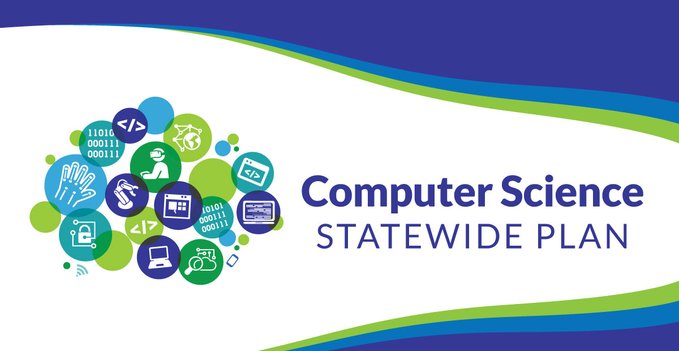
Definition of Computer Science in Wisconsin
Wisconsin defines computer science as "an academic discipline that encompasses the study of computers and algorithmic processes, including their principles, their hardware and software designs, their applications, networks, and their impact on society."
Why Computer Science is Essential in Wisconsin
As our society becomes increasingly digital, our education system must also evolve. Students need to graduate with all the tools and skills necessary to thrive in a diverse and digital society. These tools and skills include a computer science education and integrated computational thinking learning. Embedding computer science skills in K-12 core classes supports Wisconsin’s Information and Technology Literacy standards and helps all students graduate technologically literate in a digital economy. Here’s why computer science is essential in Wisconsin:
- Computer Science Skills Are Foundational And Lead to Success
- Six different studies compiled by Code.org show that students who study computer science:
- Perform better in other subjects
- Excel at problem-solving, innovation, and other future-ready technology skills
- Are 17% more likely to attend college
- Six different studies compiled by Code.org show that students who study computer science:
- Fast Growing, High Paying Jobs:
- Computing jobs are the #1 source of new wages in the United States. Computer science majors can earn 40% more than the college average.
- In Wisconsin, there are currently 6,419 open computing jobs with an average salary of $80.546. (Code.org)
- Tech careers provide job security and high salaries with opportunities for economic mobility and to close equity gaps (see data)
So why do we need a computer science Plan?
- Create a diverse computer science workforce and ensure diverse students in K-12 computer science Programming
- White males make up a large proportion of people who work in computer science careers. Only 25.2% of those that make up Computer and Math occupations nationally are women (Bureau of Labor Statistics). "Young women deserve an equal opportunity to become the next generation of entrepreneurs, engineers, and tech leaders. Closing the gap in computer science education empowers young women to build the future they want,” said Stefanie Sanford, College Board chief of Global Policy and External Relations in College Board Newsroom.
- Even in K-12 education, girls and students of color are much less likely to take computer science courses or AP computer science exams.
- Provide access to quality computer science programming for all Wisconsin students
- In Wisconsin, only 52% of public schools teach a foundational computer science course.
- According to a representative survey from Google/Gallup, 61% of principals surveyed think computer science is as or more important than required core classes. They reported that one of the biggest barriers to offering computer science is the lack of funds for hiring and training teachers.
A Wisconsin Plan for computer science can close the gaps in diversity and access statewide to computational thinking embedded learning and computer science courses.
Vision and Wisconsin State Goals
Vision:
Wisconsin's vision for computer science is to ensure all graduates have the tools and skills necessary to thrive in an increasingly evolving digital world.
State Goals for This Plan Are Organized By the Following Sections:
- Equity: Our state-level goal is to increase participation in computer science by underrepresented groups including women, underrepresented people of color, students with disabilities, and rural students. Equity also includes providing early access to computer science education; providing instruction that is relevant, accessible, and engaging; and introducing students to diverse role models. Equity will be at the forefront of any decision we make related to computer science. Educational equity means that every student has access to the resources and educational rigor they need at the right moment in their education, across race, gender, ethnicity, language, ability, sexual orientation, family background, and/or family income.
- Licensing/Certification: Our state-level goal is that all Wisconsin teachers will have access to learn the content and concepts of computer science at the elementary, middle, and high school levels. This includes preservice programs, certification/licensure, professional learning, as well as professional learning integrated into all core subjects.
- Partnerships: Our state-level goal is to use our formalized Wisconsin partnerships and professional learning networks to increase access and quality of computer science education in Wisconsin.
- Academic Standards and Instruction: Our state-level goal is to have clearly defined and easily accessible K-12 computer science standards, curriculum, and instructional materials across the K-12 system. In this effort, we will leverage standards for disciplines closely related to computer science such as national initiatives in Cybersecurity standards, AI for K12 standards, and curriculum from Cyber.org and NICE.
- Community, Career, and Communication: Our state-level goals are 1) to use strong connections and planning to increase awareness of the current computer science landscape and resources available in the state and 2) to recognize computer science career connections as part of the Digital Technology Career Pathway, including relationships to high-demand careers in associated fields such as cybersecurity.
- Funding and Program Support: Our state-level goal is to secure funding dedicated to expanding computer science education efforts.
- Data/Reporting: Our state-level goal is to measure the state of computer science education across demographics and regions to inform the state's goals.
Uses of the Plan
The Plan is a roadmap for the DPI to make strategic decisions regarding state agency resource allocation, state agency implementation, and partnerships with industry and others. Each section includes state-level goals and strategies to be implemented.
This plan provides district-level programming support with the implementation of Computer Science for All (CSforAll) SCRIPT training for K-12 curriculum and instructional practices planning. This Plan also includes planning questions and a Regional Planning Template for regions to consider when developing their local plan for computer science. At the end is a glossary of terms related to computer science and a list of resources.